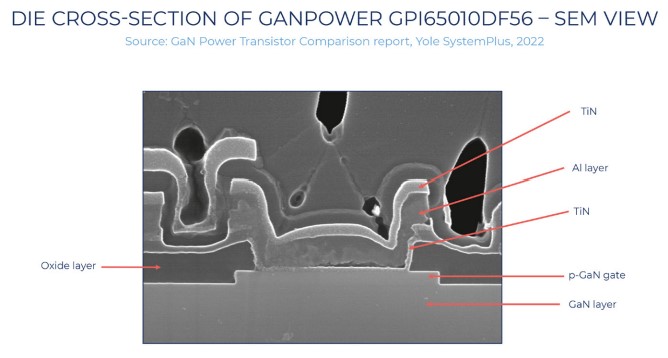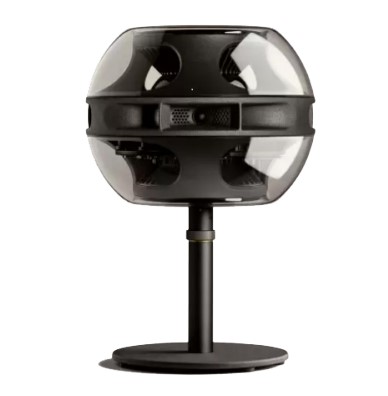GaN gains on silicon and keeps going
Gallium Nitride (GaN) has been nipping at silicon’s heels for dominance in IC design for 20 years. Its adoption is accelerating as prices fall and new uses for high power density chips are found. Caroline Hayes provides a status update.
This article originally appeared in the August '22 magazine issue of Electronic Specifier Design – see ES's Magazine Archives for more featured publications.
Analyst, Yole SystemPlus, recently published its GaN Power Transistor Comparison 2022 report, which said that the power GaN market is expected to reach $2 billion in 2027. Another analyst, Grand View Research estimates the global GaN market was worth $1.22 billion in 201 and predicts a CAGR of 24.4% between 2022 and 2030.
GaN is being adopted in many designs which exploit its faster performance, higher energy efficiency and higher operating frequencies compared with silicon (Si). Its stumbling block has been price compared with Si but the cost is coming down, says Yole SystemPlus, with prices increasingly acceptable to end users. The market has broadened from GaN-focused companies, like GaN Systems, EPC and Innoscience, to Infineon, NXP and Texas Instruments offering GaN in their device portfolio.
This has driven adoption, says Yole: “New major players like STMicroelectronics are entering the market, and there is increased adoption of monolithic power GaN ICs in various mobile charges with a power rating up to 130W at affordable prices.”
Oluwasayo Loto, technology and cost analyst at Yole SystemPlus, explains the diversity within the market and what engineers need to consider: “With GaN being a relatively new technology compared to silicon, GaN device manufacturers offer different approaches to device design, integration, and packaging. Due to the technical difficulty in GaN epitaxy, most manufacturers outsource the various stages of device manufacturing, thereby changing their business models from pure device manufacturing business models. GaN business models are now very varied”.
Market acceptance
GaN-based transistors account for 35% of the global revenue, according to Grand View Research. Markets exploiting GaN’s performance characteristics include ICT (information communication technology), where the power consumption and efficiency are an advantage for IoT-enabled products, for example, but they are also finding applications in small cell and remote networks, data centres, servers, satellite comms and base transceiver stations.
In 5G networks GaN is energy efficiency and increasingly used in monolithic microwave integrated circuit (MMIC) power amplifiers for wireless cellular basestations and also in automotive collision avoidance systems.
Space conscious
In factory automation, the robotic systems are using GaN devices in servo drives for motion control. GaN devices yield higher precision while producing a more compact drive for the motors which allows them to be used in new applications such as the motors controlling the turning circle of small, automated warehouse robots, for example.
The smaller device package size means that GaN devices are increasingly used in consumer products – particularly as the price differential with silicon reduces. In automotive design, GaN is used in lidar systems as well as lighting and navigation systems for real time driver assistance systems. It is in electric vehicles (EVs) where there is the most interest.
Dr Daniel Sherman, vice president of R&D at Visic Technologies. “Engineers can use GaN to create power electronics systems that are four times smaller and lighter and have four times less energy loss than Si-based systems,” he says. In addition, GaN devices require fewer materials to produce, lower capacitances per voltage and resistance compared to silicon, which improves switching and conduction efficiency.
EV adoption
In EV on-board charging systems, GaN technology can improve the efficiency of the inverter to increase the battery range. “GaN based technology opens the door towards faster motor frequencies, which in turn will provide even more efficient motors,” says Sherman.
“Alternatively, efficiency increases can keep the same driving distance and reduce the required battery capacity”.

Figure 1. Die cross-section of GaN Power’s GP165010DF56 (Source: Yole SystemPlus)
The need for power density and energy efficiency with compact end products are compelling arguments for GaN but GaN devices still have some technical and commercial challenges, according to Yole SystemPlus. Alongside improvements in manufacturing yield and electrical performance, there is still a need for “large-volume market adoption driven by targeted applications (for instance, automotive)” to further reduce the cost of GaN devices, advises the analysts' 2022 comparison report.

Figure 2. The Syng Cell wireless speaker has a GaN-based power supply from GaN systems which eliminates heat sinks.










